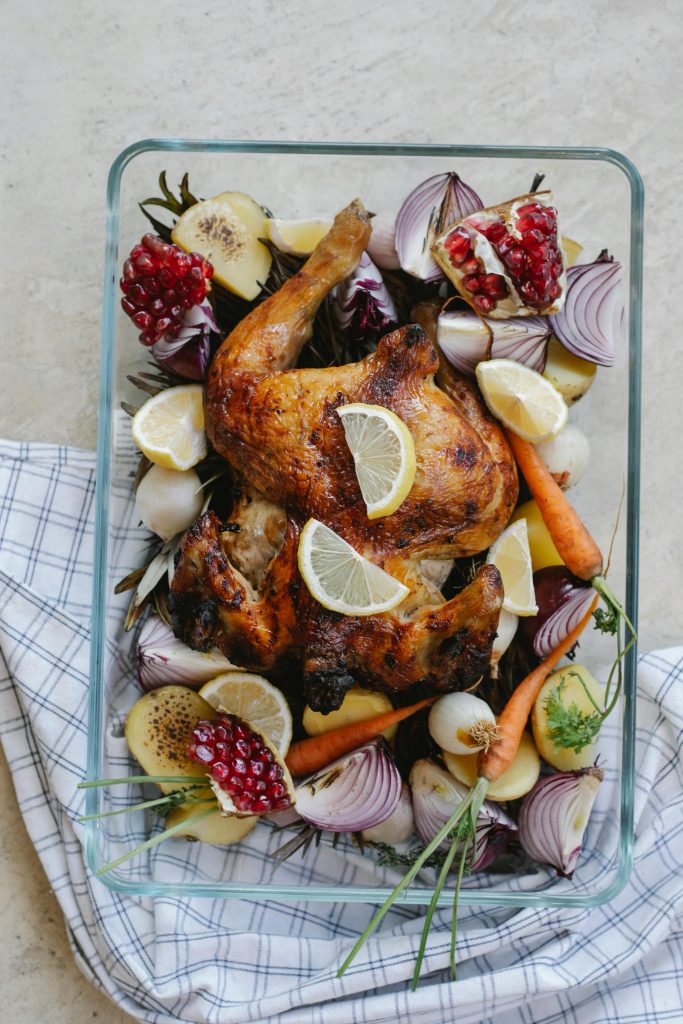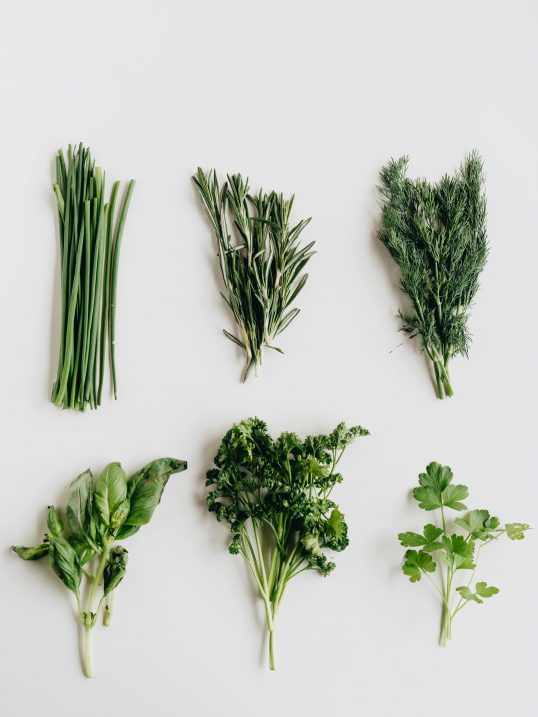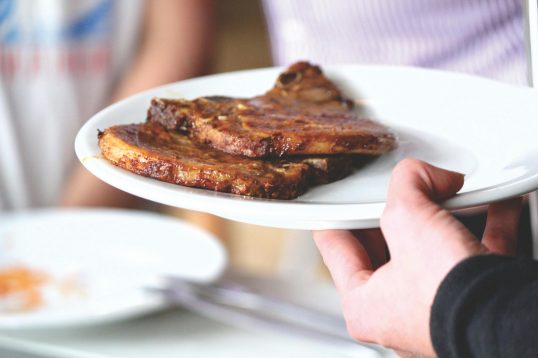Rotisserie chicken is a convenient meal option, but reheating it properly is key to maintaining its juicy texture and flavor.
This comprehensive guide covers six different methods to reheat your rotisserie chicken, with specific recommendations for when each method works best.
1. Oven Method (Best Overall)
The oven method provides the most even heating and helps maintain moisture, making it ideal for reheating larger portions or a whole chicken. The gentle, consistent heat preserves the chicken’s original texture while preventing it from drying out.
- Preheat your oven to 350°F (175°C)
- Place chicken pieces in an oven-safe dish
- Add a splash of chicken broth or water to the bottom of the dish
- Cover tightly with aluminum foil
- Heat for 20-25 minutes, or until internal temperature reaches 165°F (74°C)
Best for: Family meals, reheating whole chickens or large portions, when you want the closest taste and texture to freshly cooked rotisserie chicken, and when you’re not in a hurry.
2. Microwave Method (Quickest)
While the microwave is the fastest option, it can sometimes dry out the chicken if not done carefully. The key is using lower power and covering the chicken to trap moisture during the reheating process.
- Place chicken pieces on a microwave-safe plate
- Cover with a damp paper towel to retain moisture
- Heat on medium power (70%) for 1-2 minutes per piece
- Check the temperature and continue in 30-second intervals if needed
Best for: Quick lunches, when you’re short on time, individual portions, or when you need to quickly reheat chicken for use in another recipe.
3. Air Fryer Method (For Crispy Skin)
The air fryer is perfect for restoring crispy skin while keeping the meat juicy. This method works particularly well for chicken pieces rather than a whole chicken.
- Preheat air fryer to 350°F (175°C)
- Lightly brush chicken with oil
- Place in air fryer basket, avoiding overcrowding
- Heat for 3-4 minutes, flip, and heat for another 2-3 minutes
Best for: When you want to restore crispy skin, smaller portions like wings or thighs, or when you want that “just-cooked” texture without the long wait of an oven.
4. Stovetop Method (Versatile)
This stovetop method works well for chicken you plan to use in recipes like tacos, salads, or pasta dishes. It allows you to add flavors during the reheating process.
- Slice or shred the chicken
- Heat a skillet over medium heat with a tablespoon of oil or butter
- Add chicken and stir occasionally until warmed through (about 4-5 minutes)
- Optional: Add seasonings or sauces while reheating for extra flavor
Best for: Repurposing chicken for other recipes, when you want to add additional flavors during reheating, or when you need shredded chicken for dishes like enchiladas or chicken salad.
5. Sous Vide Method (Most Moisture Retention)
The sous vide method maintains maximum moisture and ensures even reheating throughout the chicken pieces. This method is ideal if you have the equipment and don’t mind the longer time investment.
- Place chicken pieces in a vacuum-sealed bag or zip-top bag with air removed
- Heat water bath to 140°F (60°C)
- Submerge the bagged chicken for 30-45 minutes
- Optional: Finish with a quick sear in a hot pan for crispy skin
Best for: Premium results with no risk of drying out, when you have the equipment and time, or when perfect texture is your priority over convenience.
6. Steaming Method (Gentle and Moist)
Steaming provides gentle heat and adds moisture back to the chicken, making it an excellent choice for breast meat which tends to dry out easily.
- Set up a steamer basket over simmering water
- Place chicken pieces in the steamer basket
- Cover and steam for 5-7 minutes for smaller pieces, 10-15 minutes for larger portions
- Check that internal temperature reaches 165°F (74°C)
Best for: Reheating breast meat, when you don’t need crispy skin, or when you want to add moisture back to chicken that’s already somewhat dry.
Tips for Best Results for Tasty Chicken
Proper reheating is only part of the equation – how you store and prepare your leftover rotisserie chicken can make a significant difference in the final result. These additional tips help ensure your reheated chicken remains as delicious as possible while maintaining food safety. Taking a few extra minutes to follow these recommendations will elevate your leftover chicken experience and help you avoid common reheating pitfalls.
- Always bring refrigerated chicken to room temperature for about 10 minutes before reheating
- Store leftover rotisserie chicken properly in airtight containers for up to 4 days in the refrigerator
- Remove chicken from the bone before storing for more even reheating later
- Add moisture when reheating (broth, water, or butter) to prevent drying out
- Use a meat thermometer to ensure chicken reaches 165°F (74°C) for food safety
- Consider the final use of the chicken when choosing your reheating method
- Remove skin before reheating if you’re watching fat intake
- Separate different chicken parts for more even reheating
- Freeze portions you won’t use within 3-4 days in freezer-safe bags with air removed
- Label frozen chicken with the date to track freshness
- Add a splash of lemon juice when reheating to brighten the flavor of day-old chicken
Frequently Asked Questions
How long can I keep leftover rotisserie chicken in the refrigerator?
Properly stored rotisserie chicken can be kept in the refrigerator for 3-4 days. Store it in airtight containers and ensure your refrigerator temperature is set to 40°F (4°C) or below. If you won’t consume it within this timeframe, consider freezing portions for longer storage.
Can I reheat rotisserie chicken more than once?
It’s not recommended to reheat chicken multiple times. Each reheating cycle increases the risk of foodborne illness and degrades the quality of the meat. Instead, only reheat the portion you plan to eat immediately.
Is it safe to reheat chicken in its original container?
Most store-bought rotisserie chicken containers aren’t designed for reheating. Transfer chicken to oven-safe or microwave-safe dishes depending on your chosen reheating method, to ensure even heating and avoid potentially harmful chemicals leaching from packaging not designed for high heat.
How can I tell if my leftover rotisserie chicken has gone bad?
Look for signs of spoilage such as a sour smell, slimy texture, or changes in color (especially grayish or greenish tints). If in doubt, it’s safer to discard the chicken than risk foodborne illness.
What’s the best way to reheat rotisserie chicken for a sandwich?
For sandwiches, the microwave or stovetop methods work best. Slice the chicken thinly before reheating for faster and more even warming. If using the microwave, heat at 50% power and check frequently to avoid overheating.
How can I add flavor to my reheated rotisserie chicken?
Enhance reheated chicken by adding fresh herbs, a squeeze of lemon or lime juice, or warming it with a bit of broth or butter. For more substantial flavor changes, consider tossing with sauces like BBQ, teriyaki, or buffalo sauce after reheating.
Can I freeze a whole rotisserie chicken?
While possible, it’s better to carve and separate the chicken before freezing. Remove meat from bones, divide into meal-sized portions, and store in freezer-safe containers or bags with air removed. This approach allows for easier and quicker thawing and reheating later.
What’s the best way to reheat frozen rotisserie chicken?
For best results, thaw frozen chicken overnight in the refrigerator before reheating. If you need to reheat from frozen, use the oven method at a lower temperature (325°F/163°C) and extend the cooking time by about 50%, always ensuring the internal temperature reaches 165°F (74°C).
Insider’s Insight
The beauty of rotisserie chicken lies in its versatility. Whether you’re enjoying it as a simple protein with side dishes, incorporating it into complex recipes, or creating quick meals on busy weeknights, properly reheated chicken can taste nearly as good as fresh.
Following these methods, you can enjoy your rotisserie chicken as juicy and flavorful as when you first brought it home!






